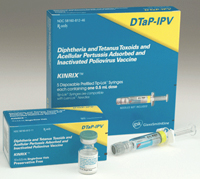Product
Kinrix
Approval Date
June 24, 2008
Release Date
July 18, 2008
Company
GlaxoSmithKline
Class
Vaccine (DTaP + IPV)
Indication
Immunization against diphtheria, tetanus, pertussis, and polio: As the 5th dose in the DTaP immunization series and the 4th dose in the inactivated poliovirus vaccine (IPV) series in children 4–6 years of age (before 7th birthday) who previously received Infanrix (DTaP) and/or Pediarix (DTaP, HB, IPV) for the first 3 doses and Infanrix for the 4th dose.
Active Ingredient
Diphtheria and tetanus toxoids, acellular pertussis vaccine, aluminum hydroxide adsorbed; inactivated polio vaccine; susp for IM inj; preservative-free; may contain trace formaldehyde, neomycin, polymixin B, polysorbate 80.
Agency Roster
Draftfcb Healthcare
Marketing Strategy/Execution
“One less ouch” is the tag line for this new pediatric booster vaccine from GlaxoSmithKline. If the line sounds familiar, that’s because another recently approved vaccine employed “One Less” in its consumer campaign slogan: Merck’s HPV vaccine Gardasil, which urged young women to be one less life affected by cervical cancer. Similarities end there, though. Kinrix was approved for use in children 4 to 6 years old to offer protection against diphtheria, tetanus, pertussis and polio diseases in one shot. Physicians previously had to administer two sticks to cover all three bases, hence the promise of “less ouch” with Kinrix.
GSK got a boost when the Centers for Disease Control and Prevention recommended use of Kinrix along with the company’s two-dose rotavirus vaccine Rotarix (approved in April). GSK knows how to promote vaccines; the franchise also includes flu and H5N1 shots, as well as an HPV vaccine in development, Cervarix. Nevertheless, the marketer may be hoping some of Gardasil’s mojo rubs off when it launches Kinrix in mid-July 2008.
Also in the Pipeline
No competitor compounds in phase III or pre-registration, US.
Recent MM&M Coverage
The Top 60: Draftfcb Healthcare
Pharmacology
Kinrix is a combination vaccine for children intended to provide protection against diphtheria, tetanus, pertussis and polio in one injection. The diphtheria, tetanus, and pertussis components of Kinrix are the same as those in Infanrix and Pediarix (also from GSK), and the poliovirus component is the same as that in Pediarix.
Clinical Trials
In a randomized, controlled study conducted in the US, 3,156 children 4 to 6 years of age who were previously immunized with four doses of DTaP and 3 doses of IPOL (from Sanofi Pasteur) were immunized with Kinrix. All children also were given the 2nd dose of MMR II (from Merck) concomitantly administered at separate sites. The control group was given Infanrix and IPOL vaccines. Levels of antibodies to the diphtheria, tetanus, pertussis and poliovirus antigens were measured in sera obtained immediately prior to immunization and one month after vaccination. Kinrix offered similar protection to its component vaccines given separately with a similar safety profile. It was non-inferior to Infanrix and IPV given separately, in terms of booster responses to DTaP antigens and post-vaccination antibody titers for anti-polio antibodies.
Adverse Reactions
Injection site pain, redness, local swelling, increase in arm circumference, drowsiness, fever, appetite loss.
Adults
Not applicable
Children
<4 years or =7 years: not recommended. 4–6 years: One dose of 0.5mL in deltoid muscle.
Contraindications
Anaphylaxis associated with previous diphtheria, tetanus, pertussis, or polio vaccine. Encephalopathy within 7 days of previous pertussis vaccine. Progressive neurological disorders (eg, infantile spasms, uncontrolled epilepsy).
Precautions
Guillain-Barre syndrome within 6 weeks of previous tetanus vaccination. Fever (=105°F within 48 hours), persistent inconsolable crying (=3 hours within 48 hours), shock (within 48 hours), or seizures (within 3 days) after previous pertussis vaccine: see literature. Seizure risk: may pretreat with antipyretic. Latex allergy (prefilled syringes). Have epinephrine available. Pregnancy (Cat.C): not applicable.
Interactions
May give with concomitant vaccines (eg, MMR). Immunosuppressants (eg, radiation, chemotherapy, high-dose steroids): may get suboptimal response.









